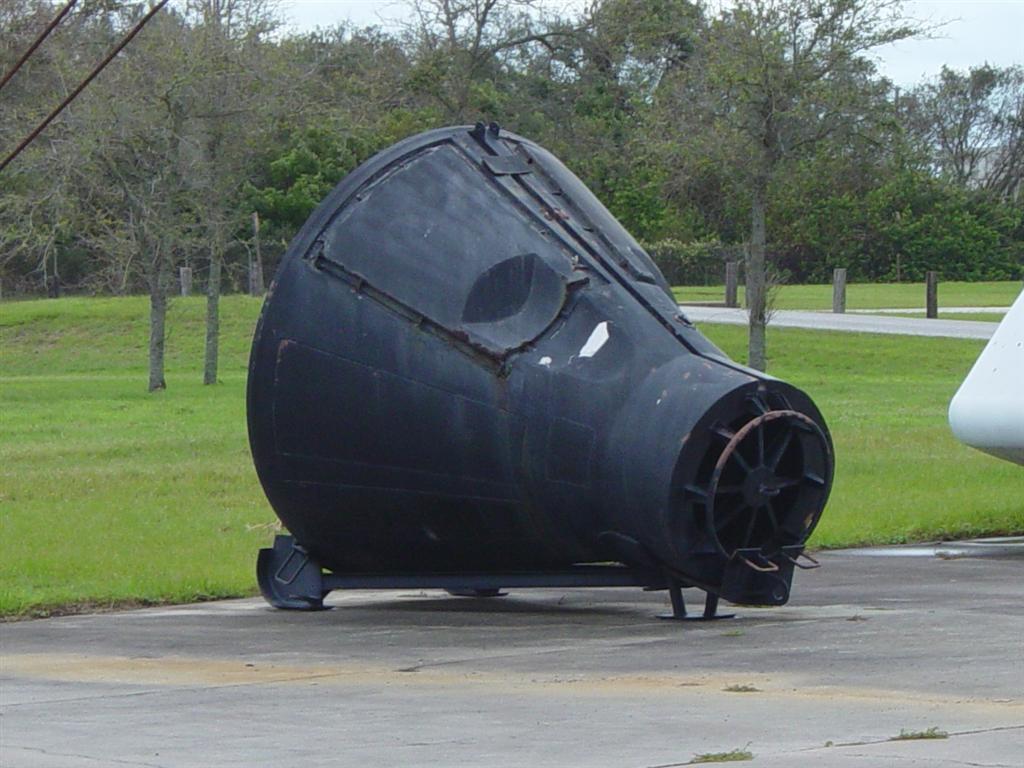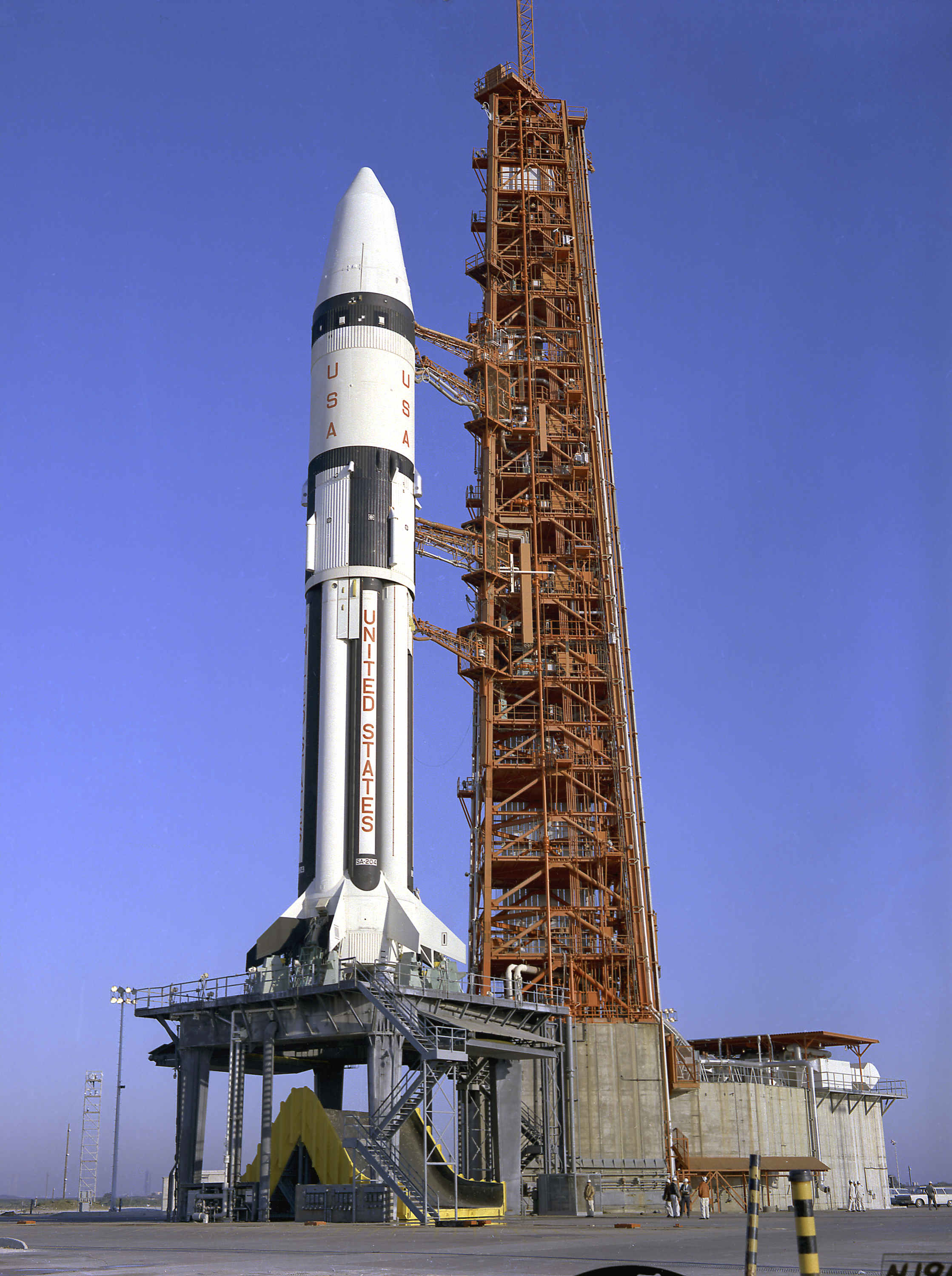|
AS-101
AS-101 (also designated SA-6) was the sixth flight of the Saturn I launch vehicle, which carried the first boilerplate Apollo spacecraft into low Earth orbit. The test took place on May 28, 1964, lasting for four orbits (about six hours). The spacecraft and its upper stage completed a total of 54 orbits before reentering the atmosphere and crashing in the Pacific Ocean on June 1, 1964. The flight experienced a single anomaly: one of the eight first-stage Saturn I engines shut down early, but the guidance system compensated by burning the remaining seven engines longer. AS-101 was followed by four more flights to verify the launch aerodynamics of the Apollo command and service module (CSM) and its launch escape system (LES) tower. Boilerplate Apollo The first five launches of the Saturn I had carried Jupiter nosecones, a proven design which allowed engineers to focus on development of the rocket. To verify the launch aerodynamics of the CSM, AS-101 carried BP-13, a boilerplat ... [...More Info...] [...Related Items...] OR: [Wikipedia] [Google] [Baidu] |
AS-102
AS-102 (also designated SA-7) was the seventh flight of the Saturn I launch vehicle, which carried the boilerplate Apollo spacecraft BP-15 into low Earth orbit. The test took place on September 18, 1964, lasting for five orbits (about seven and a half hours). The spacecraft and its upper stage completed 59 orbits before reentering the atmosphere and crashing in the Indian Ocean on September 22, 1964. Objectives AS-102 was designed to repeat the flight of AS-101. It would once again carry a boilerplate Apollo command and service module. The only difference from Boilerplate 13 carried on AS-101 was that on Boilerplate 15, one of the simulated reaction control system thruster quads (attitude control thrusters) was instrumented to record launch temperatures and vibrations. Another major difference on AS-102 was that the launch escape system (LES) tower would be jettisoned using the launch escape and pitch control motors. AS-102 was the first time a Saturn rocket carried a programma ... [...More Info...] [...Related Items...] OR: [Wikipedia] [Google] [Baidu] |
Boilerplate (spaceflight)
A boilerplate spacecraft, also known as a mass simulator, is a nonfunctional craft or payload that is used to test various configurations and basic size, load, and handling characteristics of rocket launch vehicles. It is far less expensive to build multiple, full-scale, non-functional boilerplate spacecraft than it is to develop the full system (design, test, redesign, and launch). In this way, boilerplate spacecraft allow components and aspects of cutting-edge aerospace projects to be tested while detailed contracts for the final project are being negotiated. These tests may be used to develop procedures for mating a spacecraft to its launch vehicle, emergency access and egress, maintenance support activities, and various transportation processes. Boilerplate spacecraft are most commonly used to test crewed spacecraft; for example, in the early 1960s, NASA performed many tests using boilerplate Apollo spacecraft atop Saturn I rockets, and Mercury spacecraft atop Atlas rocke ... [...More Info...] [...Related Items...] OR: [Wikipedia] [Google] [Baidu] |
Saturn I
The Saturn I was a rocket designed as the United States' first medium lift launch vehicle for up to low Earth orbit payloads.Terminology has changed since the 1960s; back then, 20,000 pounds was considered "heavy lift". The rocket's first stage was built as a cluster of propellant tanks engineered from older rocket tank designs, leading critics to jokingly refer to it as "Cluster's Last Stand". Its development was taken over from the Advanced Research Projects Agency in 1958 by the newly formed civilian NASA. Its design proved sound and flexible. It was successful in initiating the development of liquid hydrogen-fueled rocket propulsion, launching the Pegasus satellites, and flight verification of the Apollo command and service module launch phase aerodynamics. Ten Saturn I rockets were flown before it was replaced by the heavy lift derivative Saturn IB, which used a larger, higher total impulse second stage and an improved guidance and control system. It also led the way to ... [...More Info...] [...Related Items...] OR: [Wikipedia] [Google] [Baidu] |
Boilerplate (spacecraft)
A boilerplate spacecraft, also known as a mass simulator, is a nonfunctional craft or payload that is used to test various configurations and basic size, load, and handling characteristics of rocket launch vehicles. It is far less expensive to build multiple, full-scale, non-functional boilerplate spacecraft than it is to develop the full system (design, test, redesign, and launch). In this way, boilerplate spacecraft allow components and aspects of cutting-edge aerospace projects to be tested while detailed contracts for the final project are being negotiated. These tests may be used to develop procedures for mating a spacecraft to its launch vehicle, emergency access and egress, maintenance support activities, and various transportation processes. Boilerplate spacecraft are most commonly used to test crewed spacecraft; for example, in the early 1960s, NASA performed many tests using boilerplate Apollo spacecraft atop Saturn I rockets, and Mercury spacecraft atop Atlas rocke ... [...More Info...] [...Related Items...] OR: [Wikipedia] [Google] [Baidu] |
Cape Canaveral Air Force Station Space Launch Complex 37
Space Launch Complex 37 (SLC-37), previously Launch Complex 37 (LC-37), is a launch complex on Cape Canaveral Space Force Station, Florida. Construction began in 1959 and the site was accepted by NASA to support the Saturn I program in 1963. The complex consists of two launch pads. LC-37A has never been used, but LC-37B launched uncrewed Saturn I flights (1964 to 1965) and was modified and launched Saturn IB flights (1966 to 1968), including the first (uncrewed) test of the Apollo Lunar Module in space (Apollo 5). It was deactivated in 1972. In 2001 it was modified as the launch site for Delta IV, a launch system operated by United Launch Alliance. The original layout of the launch complex featured one Mobile Service Structure which could be used to service or mate a rocket on either LC-37A or 37B, but not on both simultaneously. The Delta IV Mobile Service Tower is tall, and fitted to service all Delta IV configurations, including the Delta IV Heavy. Launch history Rocket con ... [...More Info...] [...Related Items...] OR: [Wikipedia] [Google] [Baidu] |
Saturn I SA-5
Saturn-Apollo 5 (SA-5) was the first launch of the Block II Saturn I rocket and was part of the Apollo program. In 1963, President Kennedy identified this launch as the one which would place US lift capability ahead of the Soviets, after being behind for more than six years since Sputnik. Upgrades and objectives The major changes that occurred on SA-5 were that for the first time the Saturn I would fly with two stages - the S-I first stage and the S-IV second stage. The second stage featured six engines burning liquid hydrogen. Although this engine design (RL10) was meant to be tested several years earlier in the Centaur upper stage, in the end the first Centaur was launched only two months before SA-5. This rocket stage was delivered to the Cape by a modified B-377 aircraft, the ''Aero Spacelines Pregnant Guppy''. Other major design changes included the enlargement of the fuel tanks on the first stage. For the first time the rocket would carry its planned 750,000 lb (340,000 ... [...More Info...] [...Related Items...] OR: [Wikipedia] [Google] [Baidu] |
SA-5 (Apollo)
Saturn-Apollo 5 (SA-5) was the first launch of the Block II Saturn I rocket and was part of the Apollo program. In 1963, President Kennedy identified this launch as the one which would place US lift capability ahead of the Soviets, after being behind for more than six years since Sputnik. Upgrades and objectives The major changes that occurred on SA-5 were that for the first time the Saturn I would fly with two stages - the S-I first stage and the S-IV second stage. The second stage featured six engines burning liquid hydrogen. Although this engine design (RL10) was meant to be tested several years earlier in the Centaur upper stage, in the end the first Centaur was launched only two months before SA-5. This rocket stage was delivered to the Cape by a modified B-377 aircraft, the ''Aero Spacelines Pregnant Guppy''. Other major design changes included the enlargement of the fuel tanks on the first stage. For the first time the rocket would carry its planned 750,000 lb (340,000& ... [...More Info...] [...Related Items...] OR: [Wikipedia] [Google] [Baidu] |
Kanton Island
Canton Island (also known as Kanton or Abariringa), previously known as Mary Island, Mary Balcout's Island or Swallow Island, is the largest, northernmost, and , the sole inhabited island of the Phoenix Islands, in the Republic of Kiribati. It is an atoll located in the South Pacific Ocean roughly halfway between Hawaii and Fiji. The island is a narrow ribbon of land around a lagoon; an area of . Canton's closest neighbour is the uninhabited Enderbury Island, west-southwest. The capital of Kiribati, South Tarawa, lies to the west. , the population was 20, down from 61 in 2000. The island's sole village is called Tebaronga. Kiribati declared the Phoenix Islands Protected Area in 2006, with the park being expanded in 2008. The marine reserve contains eight coral atolls, including Canton. Because it is inhabited, management of Canton Island is described in the Canton Resource Use Sustainability Plan (KRUSP), which covers a radius around the atoll. Over 50% of the island and lago ... [...More Info...] [...Related Items...] OR: [Wikipedia] [Google] [Baidu] |
Pacific Ocean
The Pacific Ocean is the largest and deepest of Earth's five oceanic divisions. It extends from the Arctic Ocean in the north to the Southern Ocean (or, depending on definition, to Antarctica) in the south, and is bounded by the continents of Asia and Oceania in the west and the Americas in the east. At in area (as defined with a southern Antarctic border), this largest division of the World Ocean—and, in turn, the hydrosphere—covers about 46% of Earth's water surface and about 32% of its total surface area, larger than Earth's entire land area combined .Pacific Ocean . '' Britannica Concise.'' 2008: Encyclopædia Britannica, Inc. The centers of both the |
Turbopump
A turbopump is a propellant pump with two main components: a rotodynamic pump and a driving gas turbine, usually both mounted on the same shaft, or sometimes geared together. They were initially developed in Germany in the early 1940s. The purpose of a turbopump is to produce a high-pressure fluid for feeding a combustion chamber or other use. There are two types of turbopumps: a centrifugal pump, where the pumping is done by throwing fluid outward at high speed, or an axial-flow pump, where alternating rotating and static blades progressively raise the pressure of a fluid. Axial-flow pumps have small diameters but give relatively modest pressure increases. Although multiple compression stages are needed, axial flow pumps work well with low-density fluids. Centrifugal pumps are far more powerful for high-density fluids but require large diameters for low-density fluids. History Early development High-pressure pumps for larger missiles had been discussed by rocket pioneers su ... [...More Info...] [...Related Items...] OR: [Wikipedia] [Google] [Baidu] |
NASA
The National Aeronautics and Space Administration (NASA ) is an independent agency of the US federal government responsible for the civil space program, aeronautics research, and space research. NASA was established in 1958, succeeding the National Advisory Committee for Aeronautics (NACA), to give the U.S. space development effort a distinctly civilian orientation, emphasizing peaceful applications in space science. NASA has since led most American space exploration, including Project Mercury, Project Gemini, the 1968-1972 Apollo Moon landing missions, the Skylab space station, and the Space Shuttle. NASA supports the International Space Station and oversees the development of the Orion spacecraft and the Space Launch System for the crewed lunar Artemis program, Commercial Crew spacecraft, and the planned Lunar Gateway space station. The agency is also responsible for the Launch Services Program, which provides oversight of launch operations and countdown management f ... [...More Info...] [...Related Items...] OR: [Wikipedia] [Google] [Baidu] |
H-1 (rocket Engine)
The Rocketdyne H-1 was a thrust liquid-propellant rocket engine burning LOX and RP-1. The H-1 was developed for use in the S-I and S-IB first stages of the Saturn I and Saturn IB rockets, respectively, where it was used in clusters of eight engines. After the Apollo program, surplus H-1 engines were rebranded and reworked as the Rocketdyne RS-27 engine with first usage on the Delta 2000 series in 1974. The RS-27 variant is also used on the Delta II and Delta III. History Early engines The H-1 is one of a series of engines developed from the wartime V-2 ballistic missile. During the war, North American Aviation (NAA) was given several V-2 engines to examine and convert from metric to SAE measurements. They formed their "Propulsion Division" to handle this work, later becoming Rocketdyne. NAA had also been given a wealth of technical documentation on the engine. Engineers studying them came across plans to improve the V-2 engine using a new "waterfall" fuel injector. The Ge ... [...More Info...] [...Related Items...] OR: [Wikipedia] [Google] [Baidu] |







.jpg)
